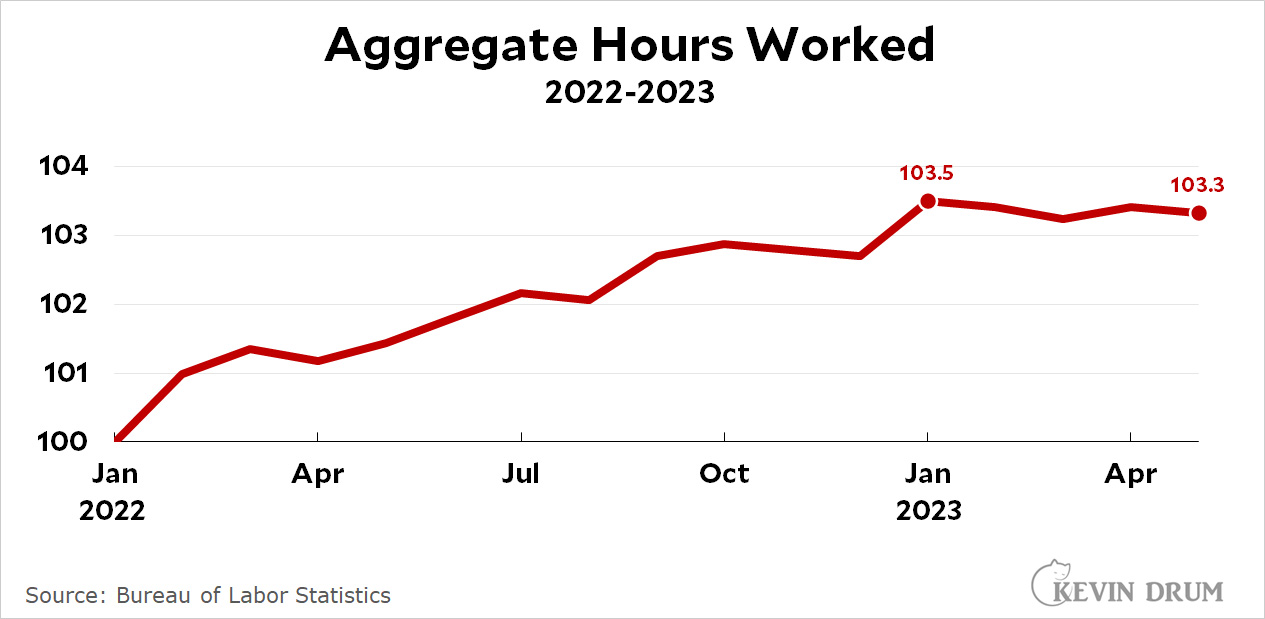Yesterday I noted that although the number of jobs was up, the number of employed people was down considerably while the number of unemployed people was up. This divergence represents one of the ongoing mysteries of the labor market. Is it strong or is it weak?
Here's another mystery: aggregate hours worked:
 Through the end of 2022, workers were putting in more hours, which is consistent with a strong labor market. However, that flattened out this year and aggregate hours even declined 1% in May. This is consistent with a weak labor market.
Through the end of 2022, workers were putting in more hours, which is consistent with a strong labor market. However, that flattened out this year and aggregate hours even declined 1% in May. This is consistent with a weak labor market.
My take is that nearly all labor signals have been flat or weak since the beginning of the year. Even the basic employment numbers, though still positive, have been trending downward for over a year:
 All of this is provisional. The labor market is just a mystery right now, and I don't think anyone knows for sure just how strong it is.
All of this is provisional. The labor market is just a mystery right now, and I don't think anyone knows for sure just how strong it is.

Myabe some of the jobs were taken by ChatGPT?
the industries that are adding significant jobs are also industries that offer shorter hours. Retail, leisure & hospitality, home health.
You should consider looking at longer horizons. Therein, you can clearly see how everything had a pandemic-induced distortion, including work hours.
Kevin
consider this.
People who were born in 1963 are turning 70 this year. Per 1,000 people births were at 21.012 in 1963. That is DOWN from 24.099 in 1953 but not by much.
In 1973 the birthrate was at 15.631.
From 21.012 in '63 to 15.631 in '73 is a decline of almost 25%. IN ONE DECADE
The republicans clamoring for tighter borders might want to rethink their strategy.
Because starting NOW the number of workers available is going to decline almost 25% over the next decade. The ongoing decline in people of working age is going to reverberate throughout all of "statistics - land" for a good long while. Using 20 year olds as the average worker age entering the work force how many people are turning 20 in 2023? Look at the birth rate from 2003 it was 14.033. Thats a decline of almost 33% from 1963 (not counting immigration)
There will not be enough people to fly our shiny new fighter jets
nor
Man our new M1A1Abrams tanks
nor
Occupy all our housing
nor
shop in all our stores
And so on...........
The ramifications of this decline in birthrates will be felt for quite some time.
Hell, we're just now realizing just how bad it's going to get.
@Vog46
Because starting NOW the number of workers available is going to decline almost 25% over the next decade
Not so. You're failing to take into account the effects of younger cohorts (ie, those born in 90s, 2000s, etc) born when the denominator (overall US population) was larger, which partially counteracted the effects of a lower birth rate—as well as immigration. There may not be any decline at all in the number of available US workers over the next decade, much less a 25% decline. The Bureau of Labor Statistics projects an increase of about 8 million over the course of the 2020s, and a 2020-2050 increase of some 35 million.
Check out the graph on page 4:
https://www.bls.gov/opub/mlr/2012/10/art1full.pdf
which is why I said the Republicans clamoring for tighter border control may wat to rethink their strategy.
why does the government think that more older workers will be in the workforce by 2050 (according to the article)????